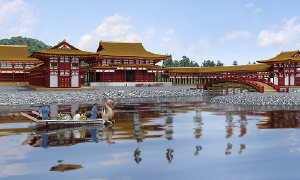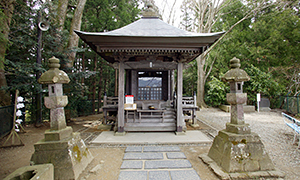Hiraizumi—History's Stage

Already in Kiyohira’s time it appears that the court was concerned that he might “seize royal lands and foment rebellion.” But while the court saw this problem in terms of the theft of public land, for Kiyohira the expansion of private estates (many held in proxy for powerful men in the capital) was part of the policy of independent local development that had been the hallmark of the region since the glory days of his mother’s family, the Abe. A number of men serving under the twelfth-century equivalent of the premier (the highest-ranking official in the court power structure) even ignored imperial law to flee Kyoto and remain by Kiyohira’s side in Ōshū. Their behavior is illustrative of the extent to which the people of the time were drawn to Michinoku.
During the reign of Kiyohira’s heir, Motohira, officials sent to the north complained that it was “as if we have no authority.” Motohira also stonewalled the “Fearsome Minister of the Left” Fujiwara no Yorinaga, a powerful member of the Fujiwara regent family, over Yorinaga’s desire for increased revenues from his private estates being stewarded by Hiraizumi. Even a noble like Yorinaga could no longer assert central authority with impunity—if anything, it cost the nobleman a great deal of political capital when he was thwarted by a “northern barbarian.”
The latter half of the twelfth century was a time of incredible upheaval in Japan. The Hōgen Disturbance of 1156 signaled the failing authority of the ancient state, and opened the door for the warriors to take power over their erstwhile masters. Michinoku was not unaffected. The third of the Hiraizumi Fujiwara, Hidehira, was promoted to the prestigious post of peacekeeping general in 1170, then to governor of Mutsu province in 1181. This was not just de jure recognition of the de facto control exercised by the Hiraizumi Fujiwara over the Ōshū region, but the legitimation of the Hiraizumi polity by the central government.
This was not just lip service to Hiraizumi, either. It was recognition of the realpolitik that the outcome of the increasing tensions between Kyoto and the nascent warrior regime in Kamakura led by Minamoto no Yoritomo would likely be decided by Hiraizumi’s support for one side or the other. This was the peak of Hiraizumi’s influence on Japanese history—never before and never since has the provincial city been so much in the spotlight of national politics. That is why the twelfth century is also known as “Hiraizumi's Century.”
Minamoto no Yoshitsune—Japan's Greatest Folk Hero

The dashing, valiant, tragic image of Minamoto no Yoshitsune—wrenched from power, torn from his lover, and hounded by his brother Yoritomo—is one of the most poignant and best loved in all of Japanese history and folklore. Yoshitsune’s first voyage to Hiraizumi was when he was just 16. It is unclear whether Hidehira had the gold merchant Kichiji bring the boy to him or whether Kichiji took the initiative himself.
There is some circumstantial evidence of a significant Hiraizumi presence in the capital: stories exist attributing Senbon Shakadō (Daiho’onji) Temple to Hidehira, and the temple is located close to Kadode Hachimangū Shrine, where Yoshitsune stopped to pray for safety on the long journey to Hiraizumi. That would surely have made it close to the home of Yoshitsune’s stepfather, Fujiwara no Naganari. It would be natural to assume, then, that Yoshitsune’s mother Tokiwa would have desired her son to flee to the safety of Hiraizumi.
After spending some time in Hiraizumi, Yoshitsune secretly left—against Hidehira’s express wishes—to join his brother Yoritomo’s rebellion against the Taira family controlling the court. Upon learning of Yoshitsune's rash decision, Hidehira sent the Satō brothers, Tsugunobu and Tadanobu, to serve and protect the Minamoto lord.
Historical accounts of Yoshitsune only cover just the eight years from his 1180 meeting with Yoritomo to his forced suicide in Hiraizumi in 1189, from his emergence on the stage of Japanese history at age 22 to his untimely death at 31. The Tale of the Heike relates his spectacular victory at Ichinotani (present-day Kobe), when Yoshitsune led a crack cavalry force down a cliff “as steep as a standing screen” to crush the Taira force from the rear, and this has become one of the most enduring episodes in Yoshitsune’s career as Minamoto field marshal. The Heike also tells of his subsequent victories against the Taira: by surprise attack at Yashima (Takamatsu) and at sea in the final and deciding battle of Dannoura (Shimonoseki). The young general’s prowess is described as unlike anything humanly possible—as a demon god of war. Undoubtedly, Yoshitsune had learned about horses in Hiraizumi; knowing that if one horse begins to run the pack will follow was the key to his brilliant strategic victory at Ichinotani.
But after his successful campaign against the Taira, Yoshitsune fell out of favor with his brother and was forced to flee back to Hiraizumi. Yoshitsune stood brooding after the death of his father figure, Hidehira. Bashō sat under his parasol and gazed at the river. And the mountains and rivers of Hiraizumi gazed back upon these two men as they have on so many others, witnesses to a long and wondrous history.
Blustery Winds—The Fall of Hiraizumi

